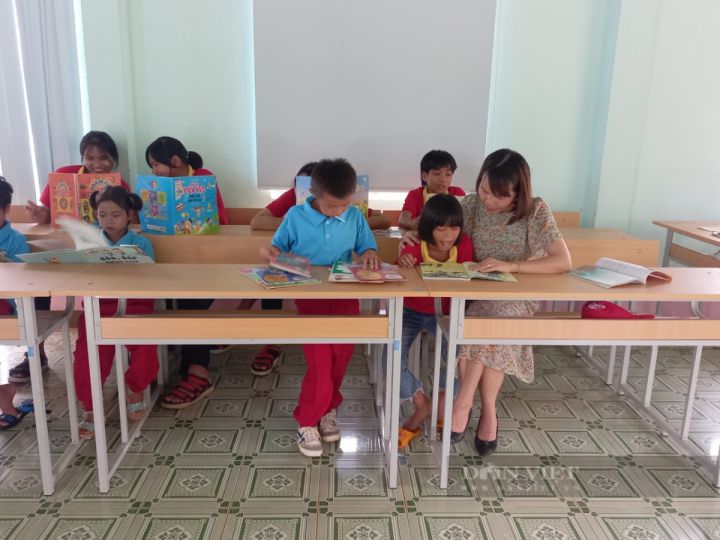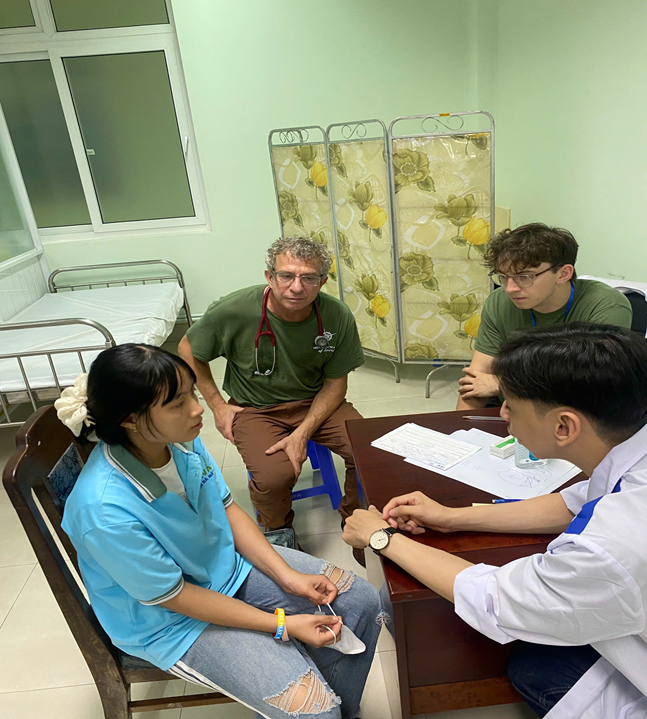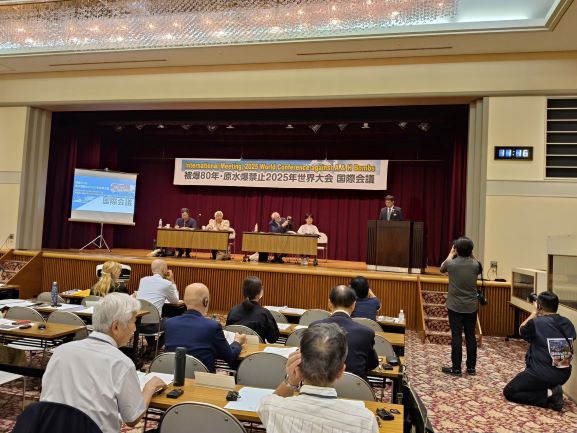I. INTRODUCTION
Accordingly, Department of National Defense of US (1961 - 1971): America had sprayed about 72 million liters of chemical toxic product in the southern Vietnam. Therein, having 44 million liters of agent orange contain dioxin.
According to Ministry of Labour, War Invalids and Social Affairs: Vietnam has about 4.8 million victims including 47,893 old soldiers. 1.2% of families/93% of communes/wards/61 provinces/cities contract agent orange/dioxin.
The physical pains of victims has led to changes about the psych, comprehension, emotional attitude and action following negative trend.
Dioxin victims are often pessimistic about their future and life, they feel difficulties to adapt to their environment.
Families have congenitally malformed children: They don’t have the conditions to study, normal activities, difficulties in integrating with community. On the other hand, they have become the sadness, pain and burden of family in looking after, nurturing and educating.
Most dioxin victims are also taken care of by relatives at home. Caring dioxin victims makes caregivers psychological stress and reduce the quality of life of them. Dioxin victims often require physical attention and prolonged care. There are many different factors that can effect the caregiver.
Caregivers have to face to face many obstacles, because they not only must take care of the victims but also have to balance with other requirements such as raising, caring for children and other relationships. They are at high risk for burden, psychological trauma, social inferiority, risk of depression and other health problems.
Aim of study:
- Estimate the right of the quality of life of victims and family members of victims.
- Assess the caring burden of family members of victims.
II. SUBJECTS AND METHOD
2.1 Subjects
- Dioxin victims: Victims of agent orange/dioxin belong to Bien Hoa city, Da Nang City and Thai Binh province.
- Family members of victims: Wife/husband or childrens, who live with victims.
2.2 Places, time
- Places: Bien Hoa city, Da Nang City and Thai Binh province.
- Time: 24 months, from 1/2014 to 12/2015.
2.3 Study design
Cross-sectional descriptive study was designed to determine the burden of care and quality of life of victims and relatives of victims of agent orange/dioxin.
2.3.1 Sample sizes and sampling: sample sizes describe
* Victims: 2,250 dioxin victims, who agree, volunteer to participate in study.
* Caregivers: 2,250 people, who are family members of dioxin victims (wife/husband or childrens, who live with victims).
* Criteria for selection of subjects:
- Victims: Recognised by Department of Labour - Invalids and Social Affairs. There is no deformation entity of nervous system, having the ability to communicate.
- Wife/husband of victims:
- Who are living together.
- No real neuropathy.
- Son of the victims:
- With or without family, living with the victims.
- No real neuropathy.
2.3.2 Content of study
- Investigating, estimating the right of the quality of life of victims of agent orange/dioxin.
- Investigating, estimating the burden of looking after and the quality of life of family members of victims of agent orange/dioxin.
2.3.3 Variables and research indexes
- Victims:
- Variables of victims: Age, sex, academic level, occupation.
- Cognitive status.
- Daily activities.
- The severity of the symptoms of behavior and mental disorder.
- The seriousness of the symptoms of behavior and mental disorder.
- The quality of life of victims following to SF36 quality of life questionnaire.
- Family members of victims:
- Variables of family members of victims: Age, sex, academic level, labour status, relative with victims, caring time victims.
- The burden of caring according to Zarit Caregiver Burden Interview/ZBI.
- Quality of life following to WHOQOL-BREF questionnaire.
- Quality of life related to health, according to 2 factors: Physical health and mental health.
2.4 Information gathering techniques
2.4.1 Victims
- Mini Mental State Examination (MMSE).
- Neuro Psychiatry Inventory (NPI): Using a neuro psychological assessment questionnaire to estimate severity level of each symptom, effect level of psychiatric symptoms.
- Activity Daily Living (ADL): Use a activity daily assessment table.
- Instrument Activity Daily Living: Use a Instrument Activity Daily Living assessment table.
- Estimating the quality of life of victims: evaluated by SF36 notes.
2.4.2 Family members of victims
- Estimating the burden of caring: by a set of ZBI votes.
- Evaluating: by a set of WHOQOL-BREF votes.
III. RESULTS AND DISCUSSION
3.1 The quality of life of the dioxin victims
Table 1. Characteristics about dioxin victims
 |
 |
The study was conducted on 2,250 dioxin victims with an average age of 72.03 ± 8.7; mainly aged 60 and over (accounting for 92.5%). Women victims accounted for 56.7%. Lower secondary education (55.8%). Former occupations of the victims were mainly workers and farmers (45%).
Table 2. Score for the quality of life of dioxin victims
 |
The average quality of life of the victims of self-assessed victims was 27.5 (± 4.1) higher than that of the caregivers of 24.7 (± 4.3) (p<0.05, mann-whitney test), only 52.9% and 47.5% of the best quality life scores. unresponsive victims (18.2 ± 2.9) was significantly lower than that mild moderate (p <0.01), 35% life.< />>
The reliability and validity of the Quality of Life Questionnaire were determined based on the results of interviews with 1,890 responding victims and 1,890 caregivers. The quality of life measured by the victim and caregiver was statistically significant (rho = 0.67, p<0.01, spearman test). the assessment of victim and caregiver’s quality life had a high intrinsic reliability (cronbach alpha="0.82).
Table 3. The quality of life of victims according to some characteristics
 |
There was no difference in the quality of life between the age groups (p>0.05, Kruskal-Wallis test), between male and female victims (p>0.05, Mann-Whitney test) according to both the caregiver assessment and the victim assessment. The quality of life according to the victim assessed no difference in cognitive decline (based on MMSE score). According to the caregivers, the quality of life of the patients with severe cognitive decline was significantly lower than that of the other two groups (p=0.009; Kruskal-Wallis test).
Table 4. Quality of life of dioxin victims according to behavioral and mental symptoms NPI.
 |
 |
The quality of life according to the victim was lower in those with depression, night sleep disorders and eating habits than those without symptoms (p<0.05). patients with signs of depression, indifference, and behavioral abnormalities at night had a significantly lower quality life compared to those without symptoms (p<0.05; mann- whitney test).< />>
Table 5. Linear regression model on a number of factors related to the quality of life of victims according to self evaluation of victims
 |
Factors of cognitive status of the victim (MMSE score), age, severity and impact of behavioral and psychological symptoms were not statistically related to quality The life of the victim according to the victim self-assessment (p> 0.05), only the victim’s gender and the daily functioning function using tools and means is significantly related to quality of life of the victim (p<0.05) but with very low coefficient. the above model explains 23.36% of quality life according to self-assessed victims.< />>
3.2 The right of burden of care, mental health and quality of life related to psychological trauma of dioxin victims
Table 6. General characteristic of relatives of victims
 |
The caregivers of dioxin victims are mainly spouses (59.0%), women (66.66%), people aged 45 and over make up 80.0%, do and earn (62.4%). Notably, one-quarter of carers over age 65, who are supposed to he rested and taken care of by others, still have to take care of the victim. The average patient care time was 10.94 ± 4.45 years. The daily care time was 4.09 ± 3.72 hours.
 |
Figure 1. The level of caring burden on a ZBI scale
43.6% of the caregivers of dioxin victims were moderately burdened and 32.0% of caregivers had a mild burden and 24.4% of caregivers were burdened at a moderate level heavy duty.
Table 7. Caring burden score ZBI of the family members of victims following some personal characteristics
 |
 |
There was no difference in caregivers’ weight scores (p>0.05; Mann-Whitney test). Caregivers aged 65 years or older had significantly higher care burden and were significantly (p<0.01; kruskal-wallis test). caregivers who did not go to work were significantly more likely care than those (p="0.001;" mann-whitney the of spousal victims higher their (p<0.01, test).< />>
Table 8. The burden of care ZBI according to level of cognitive decline (MMSE) of victims
 |
Caregivers of patients with severe cognitive impairment have a higher care burden than caregivers of mild and moderate (p<0.01) kruskal-wallis test.< />>
Table 9. Correlation between burden (ZBI) of the victim’s family and some behavioral and psychological symptoms
The severity, impact of behavioral and psychosocial symptoms are closely related to the burden of care (ZBI) (correlation coefficient 0.48 and 0.52; p<0.005), in which agitation or aggression, sleep disturbance is more relevant than other symptoms.< />>
 |
 |
Table 10. Linear regression of factors related to the burden of family members of victims
 |
Factors that were statistically significant for the caregiver burden were:
- Relative: Factors influencing the behavioral and psychiatric symptoms (NPI) of the victim with coefficient = 0.56 (p=0.01); gender of caregivers with coefficient 3.14 (p=0.12).
- Involuntary: Factors that are inversely related to the burden of the caregiver include time spent caring for the victim with a coefficient = -2.22 (p=0.53); physical health of caregivers with coefficient = -0.94 (p=0.00); mental health of caregivers with coefficient = -1.46 (p=0.01).
The results from the model show the degree to which the victim’s behavioral disorders (NPI scale), quality of life, time of illness, sex of caregiver, Physical health and mental health of careers are important characteristies that ure statistically related to the burden of caring for dioxin vietims, in which men and extended care times are the factors that most affect the caregiver’s burden. Other factors including demographic factors and MMSE scores were not correlated with the burden of care. The above model accounted for 76.12% of change in caregiver burden and significant at p<0.01.< />>
Table 11. Correlation between quality of life related to health of family members of victims and some behavioral and psychological symptoms of victims
 |
The quality of life related to the mental health of caregivers is inversely correlated with symptoms of agitation or aggression, depression or mood disturbance, but not sleep disturbance. Low levels (correlation coefficients are -0.20, -0.29 and -0.25, p<0.05 respectively). the quality of life related to physical health caregivers was negatively correlated with victim’s sleep disorder behavior (correlation coefficient="0.33;" p<0.05).< />>
Table 12. Linear regression of factors related to health of family members of victims
 |
Factors that are statistically significant for quality of life related to career health include:
- Relative agreement: Sex of the career concerned with the health of the caregiver with the coefficient of 2.856 (p=0.032);
- Involuntary: Age, burden of care related to the physical health of the caregiver with a factor of -0.234 (p=0.006) and -0.228 (p=0.001) number -0.572 (p=0.001).
The results show that the caregiver’s age increases, the quality of life associated with the physical health of the caregiver decreases, and the male caregiver has a higher quality of life related to physical health. The greater the burden of care, the lower the quality of life related to the physical health and well-being of the caregiver. The model explained 56.55% of changes in quality of life related to physical health and 51.28% of changes in quality of life related to careers’ mental health and were significant at p<0.05.< />>
IV. CONCLUSION
4.1 Determine the quality of life of people, exposed with dioxin
- The quality of life of victims is low according to estimating of victims or victim’s caregivers only from 35% to 52.9%.
- The more serious level of the cognitive decline, the occurrence and the severity level of symptoms of behavior and mental disorders is, the more decreased the quality of life is.
4.2 The burden, quality of life related health of family members of dioxin victims
- 24.4% of caregivers had burden of care at severity level (ZBI), 43.6% of family members of victims were average level, 32.0% had a low burden.
- Family members of victims expressed disorders of seriously mental behavior symptoms, having the quality of life related psychological health lower than family members of victims in low and average group (p<0.05).< />i>
REFERENCE
- Ministry of Health (2008), Document N°16: Rehabilitation of patients with mental disorders.
- Vu Dung (2010), “Agent orange/Dioxin and psychołogical damage of human” Proceeding of the Scientific conference: Psychological consequence in people exposured to toxic chemical in Vietnam war.
- Truong Thi Khanh Ha (2010), \"Investigation of psychological damage and aspiration among people exposured to agent orange/dioxin in Thai Binh province\" Proceeding of the Scientific Conference on Psychological consequence in people exposured to toxic chemical in Vietnam war.
- Nong Văn Hải, Phan Van Chỉ, Nguyen Thu Hien et. al. (2007), \"Study on detection the scientific evidences of the impact of agent orange/dioxin on victims\" National level Project, Code: DTDL-2005/29G.
- Nguyễn Công Khanh (2000), Psychotherapy (application on clinic and treatment), National University, Hanoi.
- Do Thuy Lan (2003), Evaluation of effectiveness of psycho-social rehabilitation therapy and labor therapy in reintegration to families and communities among patients with schizophrenia, Hanoi city Project, Mai Huong Mental Health Hospital.
- Nguyen Van Luot (2010), \"Effect of psychological damage in people exposured to agent orange/dioxin on their life in Viet Yen district, Bac Giang province\" Proceeding of the Scientific Conference on Psychological consequence in people exposured to toxic chemical in Vietnam war.
Nguyen Minh Phuong [1]

































.jpg)
Comment